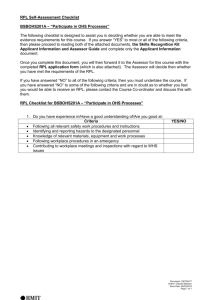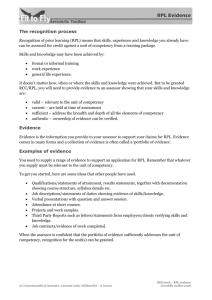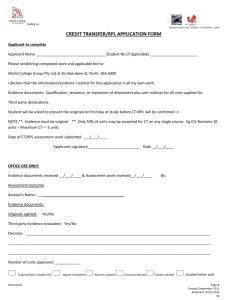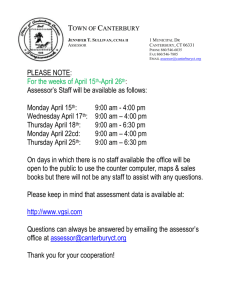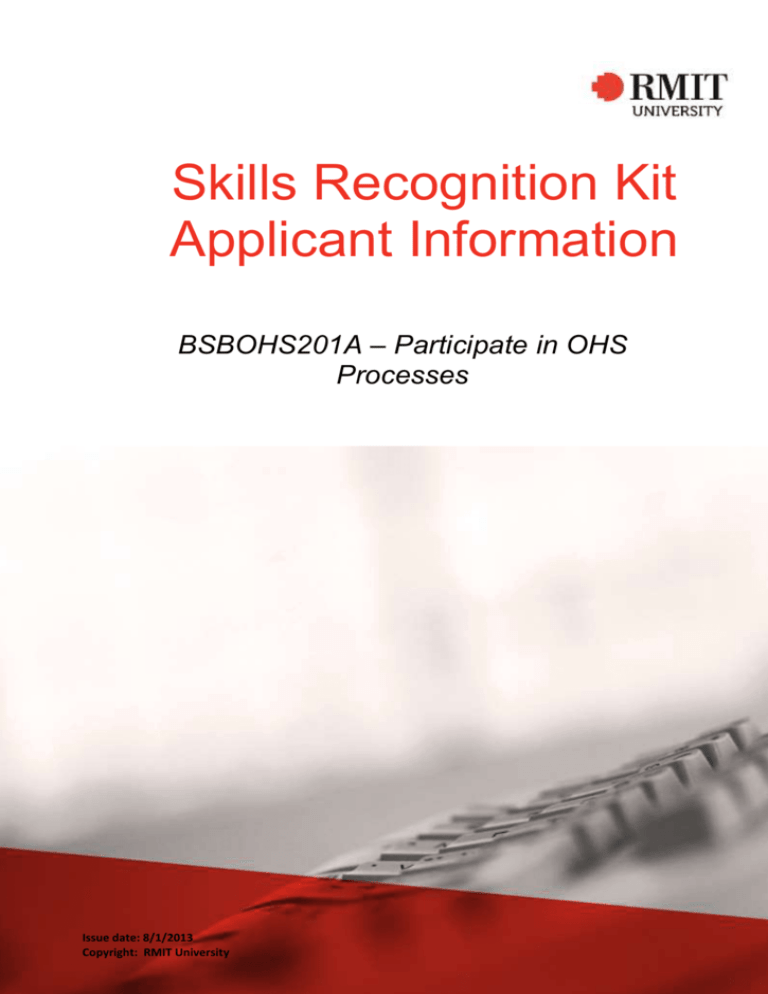
Skills Recognition Kit
Applicant Information
BSBOHS201A – Participate in OHS
Processes
Issue date: 8/1/2013
Copyright: RMIT University
ACKNOWLEDGEMENTS
© RMIT University 2013
All Rights Reserved
No part of the material in this publication may be altered for any purpose without the express
permission of the copyright holder, RMIT University.
The material contained in this publication is protected by Australian and International copyright laws.
All requests and enquiries regarding use and availability should be directed to:
The Business TAFE School
Tel. 9925 5464
Email BTSreception@rmit.edu.au
Information sourced from national Training Packages has been downloaded under license from the
National Register at http://training.gov.au
All information provided in this guide was correct at time of printing and is subject to change without
notice. RMIT takes no responsibility for any changes and strongly recommends that students refer to
websites or contact the relevant agency for current information.
Document: DPBD RPL Tool Kit
Author: C. Marasco
Save Date: 8/1/2013
Page 2 of 14
CONTENTS
Section 1: ..................................................................................................................................... 4
The Skills Recognition Process ....................................................................................................... 4
Welcome.............................................................................................................................................. 5
The Qualification ................................................................................................................................. 5
Overview of the Skills Recognition Process ......................................................................................... 6
What you need to do ........................................................................................................................... 6
Preparing Your Evidence Portfolio....................................................................................................... 8
Skills Recognition Cover Sheet ............................................................................................................. 9
SECTION 2: ................................................................................................................................. 10
Evidence Requirements .............................................................................................................. 10
General Overview .............................................................................................................................. 11
Types of Evidence .......................................................................................................................... 11
Tips and Hints ................................................................................................................................ 12
Specific Requirements ....................................................................................................................... 13
BSBOHS201A – Participate in OHS Processes ............................................................................... 13
Repeat this table as required.Evidence to be provided for this unit ............................................ 13
BSBOHS201A – Participate in OHS Processes ............................................................................... 14
Document: DPBD RPL Tool Kit
Author: C. Marasco
Save Date: 8/1/2013
Page 3 of 14
SECTION 1:
THE SKILLS RECOGNITION PROCESS
Document: DPBD RPL Tool Kit
Author: C. Marasco
Save Date: 8/1/2013
Page 4 of 14
Welcome
Welcome to the Skills Recognition process with the Business TAFE School of RMIT University. This
process involves gathering evidence about your current skills, knowledge and work skills and formally
mapping these to an appropriate qualification. It means that if you are successful, you will not need
to undertake any training as you have already met the qualification requirements through your work
and life experience.
The information in this document outlines the skills, knowledge and evidence you will need to
provide to demonstrate competence in the unit comprising the nationally recognised course,
BSBOHS201A, Participate on OHS Processes.
The Qualification
BSBOHS201A, “Participate on OHS Processes” is a core unit (competency) in the nationally
recognised program, FNS40211 Certificate IV in Bookkeeping. This qualification is designed to reflect
the job roles of contract bookkeepers and employees performing bookkeeping tasks for
organisations in a range of industries. To achieve this award, 13 units must be achieved which
comprise 9 core units and 4 elective units.
Document: DPBD RPL Tool Kit
Author: C. Marasco
Save Date: 8/1/2013
Page 5 of 14
Overview of the Skills Recognition Process
UNDERSTAND REQUIREMENTS
GATHER REQUIRED EVIDENCE
INTERVIEW/EVIDENCE REVIEW
ASSESSMENT OF EVIDENCE/SKILLS
FURTHER SUBMISSION OF EVIDENCE
(IF APPROPRIATE)
GAP TRAINING (ONLY IF REQUIRED)
ISSUE RESULTS - RTO
Document: DPBD RPL Tool Kit
Author: C. Marasco
Save Date: 8/1/2013
Page 6 of 14
What you need to do
1. Read through all the information in this document to get an idea of what is required.
2. An Assessor from The Business TAFE School will contact you regarding your understanding of
what is required and will discuss the costs with you.
NOTE: Once you decide to go ahead with the process, fees are applicable regardless of the
outcome of the skills recognition process.
3. Decide if you are going to be able to meet the evidence requirements for individual unit/s.
4. Prepare your evidence portfolio.
5. An Assessor will meet with you or contact you to discuss the evidence you have provided. They
will then review the information you have provided and begin to match up your skills to the
units/subjects in the qualification. They will identify gaps and seek additional evidence such as:
You may be asked to provide further evidence
You may be required to answer questions about the evidence provided or industry related
questions to identify your current skills – this is NOT an oral exam. It is about using the two
or three holistic questions provided to start a conversation with you which draws out your
actual experiences and relevant skills.
You may be asked to complete some practical tasks to demonstrate your competence in
particular units.
You may be asked to demonstrate practical skills (if appropriate) at your workplace or at
another suitable venue.
The assessor will be recording information during these sessions as this a requirement of the Skills
Recognition process.
6. Further steps
After the assessment, your assessor will give you information about the skills that have been
recognised and whether you have gained the full qualification. If you do have skill gaps, these may be
addressed through enrolling for some training. You will receive a Statement of Attainment or
Certificate for any units/qualification you have gained.
Document: DPBD RPL Tool Kit
Author: C. Marasco
Save Date: 8/1/2013
Page 7 of 14
Preparing Your Evidence Portfolio
1. Decide on a way to organise and present your evidence. This might be a folder with dividers
to separate your evidence into separate units. Make it as easy as possible for the Assessor to
locate the relevant information.
2. Along with your evidence you will also need to supply contact details of two work referees
who can confirm your skills in the industry. Your referees will be contacted and what they
can tell the assessor about your skills and knowledge will be documented to support the
Skills Recognition process.
3. Read the evidence requirements that outline what evidence is needed to demonstrate
competence in each unit. For more information about the criteria against which your
evidence will be assessed, please contact your Assessor.
4. Don’t forget to fill in and sign the required application forms (see below) including the
details of 2 referees and a summary of the evidence provided against each unit.
Document: DPBD RPL Tool Kit
Author: C. Marasco
Save Date: 8/1/2013
Page 8 of 14
Skills Recognition Cover Sheet
Personal Details of Applicant
Name:
Address:
Date of Birth:
Email:
Phone Contact:
Course Details
Course Title: Participate in OHS Processes
Code: BSBOHS201A
Referees – Minimum of 2 (These people will be contacted to supplement the evidence you have provided.
They should be people you have worked with, preferably supervisors who have direct knowledge of your skills
and knowledge in the requirements of this qualification)
1.
Name:
Contact Details:
Relationship to Applicant:
2.
Name:
Contact Details:
Relationship to Applicant:
Declaration
I believe that the information supplied in this application is true and correct.
Candidate signature:
Date:
<Attach your evidence portfolio to this sheet>
Document: DPBD RPL Tool Kit
Author: C. Marasco
Save Date: 8/1/2013
Page 9 of 14
SECTION 2:
EVIDENCE REQUIREMENTS
Document: DPBD RPL Tool Kit
Author: C. Marasco
Save Date: 8/1/2013
Page 10 of 14
General Overview
Skills Recognition provides opportunities for Recognition of Prior Learning (RPL) and Recognition of
Current Competence (RCC). RPL/RCC are used in the assessment process for acknowledging
previous learning and how this contributes to your current competence. Previous learning can
include relevant life and work experience as well as formal education and professional development
related to the particular qualification.
In order to apply for Skills Recognition, you will need to self-assess your skills and knowledge and
provide a portfolio of sufficient evidence to support your application. Evidence may include:
Examples of work/work records
Training you have undertaken
Assessments of current skills/current knowledge
Photographs, videos, letters and reports
Relevant credentials such as awards, certificates, statements of attainment and qualifications
Employer references
Letters from clients or members of work teams
Copy of current Curriculum Vitae including referees.
There are four key principles that must be considered when identifying possible sources of evidence.
The evidence should be:
Valid Evidence is valid when it addresses the specific evidence requirements of the competency.
Current In assessment, currency relates to the age of the evidence presented by a candidate to
demonstrate that they are still competent. Competency requires demonstration of current
performance, so the evidence collected must be from either the present or the very recent past.
Authentic To accept evidence as authentic, an assessor must be assured that the evidence
presented for assessment is the candidate’s own work.
Sufficient Sufficiency relates to the quality and quantity of evidence assessed. It requires collection
of enough appropriate evidence to ensure that all aspects of competency have been satisfied and
that competency can be demonstrated repeatedly. Supplementary sources of evidence may be
necessary. The specific evidence requirements of each unit of competency provide advice on
sufficiency.
Types of Evidence
Direct Evidence - this shows your own work, e.g. emails sent and received, projects you have
managed or been involved with, performance reviews and appraisals (both your own and those you
have conducted on staff), case files, completed documents, written reports, (as permitted by
confidentiality), examples of improvements to service, minutes from meetings, etc.
Indirect Evidence – This relates to what you or others say you can do. This includes personal reports
with verification from a line manager or referee, Certificates and Awards. Indirect evidence is often
Document: DPBD RPL Tool Kit
Author: C. Marasco
Save Date: 8/1/2013
Page 11 of 14
used to supplement/authenticate direct evidence – it is rarely used as the only confirmation of
competence.
Supporting Evidence – Oral questioning from your assessor (if required) will help determine your
knowledge and how you apply both your skill and knowledge in your work place. Assessors will often
use questioning to authenticate/supplement direct evidence - it is rarely used as the only
confirmation of competence.
Tips and Hints
Your skills and experience from the past 3 - 4 years are the most important in the assessment
because these are regarded as current.
1. Focus on your current job role, responsibilities and work history. Include your CV or jot down a
few points about where you have worked, and what you did there.
2. Include your current position description and any performance appraisals for the last two - three
years from the organisation/agency in which you have worked.
3. Collect any certificates from in-house training or formal training you have undertaken in the past.
4. Consider the possibilities for workplace contact or referees. Are you in a workplace that is
supporting your goals to get qualified? Would you feel comfortable having the assessor contact
your workplace so your skills can be validated?
5. Think about who can confirm your skill level. Current or recent supervisors who have observed
your work in the past three - four years will be able to confirm your skills. You may also have
other people who can vouch for your skill level. The assessor may need to contact them.
6. You can speak with the assessor about other ways you can show your skills. These could be
letters from employers/supervisors, records of your professional development sessions,
acknowledgements, workplace forms, reflective journals, (keeping confidentiality in mind) or
other relevant documents.
Transfer
If you currently hold a nationally recognised qualification in a related area you may be eligible for a
Transfer. You will need to produce the original testamur or a certified copy of your qualification and
the unit code and unit name on this document will need to be identical to that in the course in which
you are applying for Skills Recognition.
Appeals
Qualified and experienced assessors conduct the Skills Recognition process. If you believe your claim
for Skills Recognition has not been given fair and reasonable consideration, you can appeal the
assessment decision. More information regarding RMIT’s Appeals Process can be found at:
http://www.rmit.edu.au/browse;ID=xe27xu4dcpvm1;STATUS=A;PAGE_AUTHOR=Andrea%20Syers;SECTION=1;
How long will the Skills Recognition process take?
Once you have submitted your evidence the process should take no more than 6 weeks. The time
may increase if we need to request further evidence.
Document: DPBD RPL Tool Kit
Author: C. Marasco
Save Date: 8/1/2013
Page 12 of 14
Specific Requirements
Provide as much current evidence as you can for the following units in the document below. It is
possible that some of the requirements can be met by questioning during an interview and/or by
Third Party report.
BSBOHS201A – Participate in OHS Processes
Please complete this document with your evidence
Required
Critical aspects of evidence
Summary of evidence provided
Knowledge Requirements
Skill Requirements
Your evidence will be evaluated against the criteria associated with this unit (Please ask your assessor
if you require further information)
Repeat this table as required.
Document: DPBD RPL Tool Kit
Author: C. Marasco
Save Date: 8/1/2013
Page 13 of 14
Evidence to be provided for this unit
BSBOHS201A – Participate in OHS Processes
Required
Critical aspects of evidence
Summary of evidence provided
Provide evidence of OHS courses completed
in the workplace
Demonstrate that you can follow/understand
safety procedures, identify and report
hazards and knowledge of materials,
equipment and work processes
accurately following all relevant safety
procedures
identifying and reporting hazards to
designated personnel
knowledge of relevant health and safety
legislation
knowledge of relevant materials, equipment
and work processes.
Knowledge requirements
responsibilities of employers and employees
under relevant health and safety legislation
emergency procedures including procedures
for fires and accidents
commonly used hazard signs and safety
symbols.
Skill requirements
literacy skills to interpret safety signs,
symbols and notices
problem-solving skills to analyse options in
an emergency situation.
Demonstrate and show evidence of a
knowledge of emergency procedures in
the workplace, know what hazard signs
and symbols mean
Detail/describe your knowledge of
responsibility in relation to OHS for all
staff in an organisation
Demonstrate possess communication,
literary and problem-solving skills specific to
OHS
You could describe how you have
implemented these skills (together with the
knowledge and critical aspects) in your work
via examples
Your evidence will be evaluated against the criteria associated with this unit (Please ask your assessor
if you require further information)
Document: DPBD RPL Tool Kit
Author: C. Marasco
Save Date: 8/1/2013
Page 14 of 14

